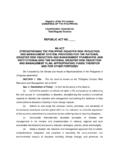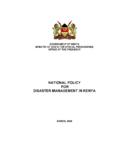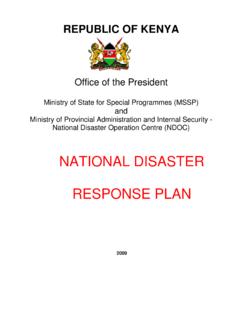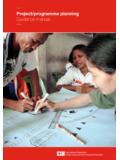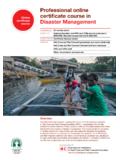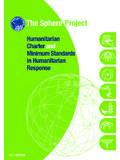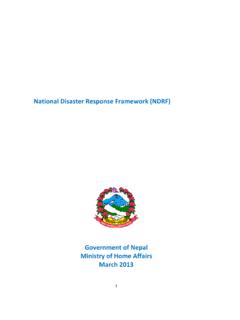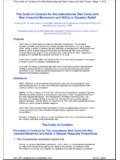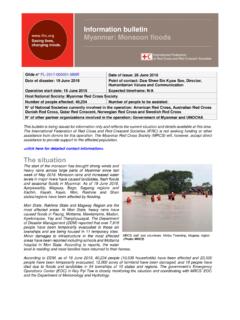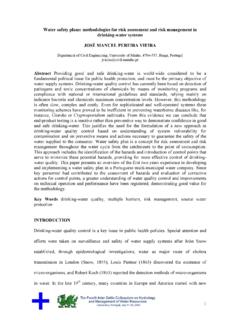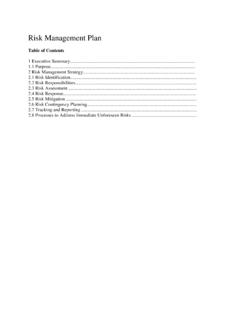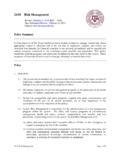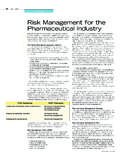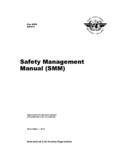Transcription of REPUBLIC ACT NO. AN ACT STRENGTHENING THE PHILIPPINE ...
1 REPUBLIC of the Philippines CONGRESS OF THE PHILIPPINES FOURTEENTH CONGRESS Third Regular Session REPUBLIC ACT NO. ____ AN ACT STRENGTHENING THE PHILIPPINE DISASTER RISK REDUCTION AND management SYSTEM, PROVIDING FOR THE NATIONAL DISASTER RISK REDUCTION AND management FRAMEWORK AND INSTITUTIONALIZING THE NATIONAL DISASTER RISK REDUCTION AND management PLAN, APPROPRIATING FUNDS THEREFOR AND FOR OTHER PURPOSES Be it enacted by the Senate and House of Representatives of the Philippines in Congress assembled: SECTION 1. Title. This Act shall be known as the PHILIPPINE Disaster Risk Reduction and management Act of 2010 . Sec. 2. Declaration of Policy. It shall be the policy of the State to: (a) Uphold the people s constitutional rights to life and property by addressing the root causes of vulnerabilities to disasters, STRENGTHENING the country s institutional capacity for disaster risk reduction and management and building the resilience of local communities to disasters including climate change impacts; (b) Adhere to and adopt the universal norms, principles, and standards of humanitarian assistance and the global effort on risk reduction as concrete expression of the country s commitment to overcome human sufferings due to recurring disasters.
2 (c) Incorporate internationally accepted principles of disaster risk management in the creation and implementation of national, regional and local sustainable development and poverty reduction strategies, policies, plans and budgets; (d) Adopt a disaster risk reduction and management approach that is holistic, comprehensive, integrated, and proactive in lessening the socio-economic and environmental impacts of disasters including climate change, and promotes the 2 involvement and participation of all sectors and all stakeholders concerned, at all levels, especially the local community; (e) Develop, promote, and implement a comprehensive National Disaster Risk Reduction and management Plan (NDRRMP) that aims to strengthen the capacity of the National Government and the local government units (LGUs), together with partner stakeholders, to build the disaster resilience of communities, and to institutionalize arrangements and measures for reducing disaster risks , including projected climate risks , and enhancing disaster preparedness and response capabilities at all levels.
3 (f) Adopt and implement a coherent, comprehensive, integrated, efficient and responsive disaster risk reduction program incorporated in the development plan at various levels of government adhering to the principles of good governance such as transparency and accountability within the context of poverty alleviation and environmental protection; (g) Mainstream disaster risk reduction and climate change in development processes such as policy formulation, socio-economic development planning, budgeting, and governance, particularly in the areas of environment, agriculture, water, energy, health, education, poverty reduction, land-use and urban planning, and public infrastructure and housing, among others; (h) Institutionalize the policies, structures, coordination mechanisms and programs with continuing budget appropriation on disaster risk reduction from national down to local levels towards building a disaster-resilient nation and communities; (i) Mainstream disaster risk reduction into the peace process and conflict resolution approaches in order to minimize loss of lives and damage to property, and ensure that communities in conflict zones can immediately go back to their normal lives during periods of intermittent conflicts; (j) Ensure that disaster risk reduction and climate change measures are gender responsive, sensitive to indigenous knowledge systems, and respectful of human rights.
4 3 (k) Recognize the local risk patterns across the country and strengthen the capacity of LGUs for disaster risk reduction and management through decentralized powers, responsibilities, and resources at the regional and local levels; (l) Recognize and strengthen the capacities of LGUs and communities in mitigating and preparing for, responding to, and recovering from the impact of disasters; (m) Engage the participation of civil society organizations (CSOs), the private sector and volunteers in the government s disaster risk reduction programs towards complementation of resources and effective delivery of services to the citizenry; (n) Develop and strengthen the capacities of vulnerable and marginalized groups to mitigate, prepare for, respond to, and recover from the effects of disasters; (o) Enhance and implement a program where humanitarian aiId workers, communities, health professionals, government aid agencies, donors, and the media are educated and trained on how they can actively support breastfeeding before and during a disaster and/or an emergency; and (p) Provide maximum care, assistance and services to individuals and families affected by disaster, implement emergency rehabilitation projects to lessen the impact of disaster, and facilitate resumption of normal social and economic activities.
5 SEC. 3. Definition of Terms. For purposes of this Act, the following shall refer to: (a) Adaptation - the adjustment in natural or human systems in response to actual or expected climatic stimuli or their effects, which moderates harm or exploits beneficial opportunities. (b) Capacity - a combination of all strengths and resources available within a community, society or organization that can reduce the level of risk, or effects of a disaster. Capacity may include infrastructure and physical means, institutions, societal coping abilities, as well as human knowledge, skills and collective attributes such as social relationships, leadership and management . Capacity may also be described as capability. (c) Civil Society Organizations or CSOs non-state actors whose aims are neither to generate profits nor to seek governing power.
6 CSOs unite people to advance shared goals and interests. They have a presence in public life, expressing the interests 4 and values of their members or others, and are based on ethical, cultural, scientific, religious or philanthropic considerations. CSOs include nongovernment organizations (NGOs), professional associations, foundations, independent research institutes, community-based organizations (CBOs), faith-based organizations, people s organizations, social movements, and labor unions. (d) Climate Change - a change in climate that can be identified by changes in the mean and/or variability of its properties and that persists for an extended period typically decades or longer, whether due to natural variability or as a result of human activity. (e) Community-Based Disaster Risk Reduction and management or CBDRRM - a process of disaster risk reduction and manAagement in which at risk communities are actively engaged in the identification, analysis, treatment, monitoring and evaluation of disaster risks in order to reduce their vulnerabilities and enhance their capacities, and where the people are at the heart of decision-making and implementation of disaster risk reduction and management activities.
7 (f) Complex Emergency - a form of human-induced emergency in which the cause of the emergency as well as the assistance to the afflicted is complicated by intense level of political considerations. (g) Contingency Planning - a management process that analyzes specific potential events or emerging situations that might threaten society or the environment and establishes arrangements in advance to enable timely, effective and appropriate responses to such events and situations. (h) Disaster - a serious disruption of the functioning of a community or a society involving widespread human, material, economic or environmental losses and impacts, which exceeds the ability of the affected community or society to cope using its own resources. Disasters are often described as a result of the combination of: the exposure to a hazard; the conditions of vulnerability that are present; and insufficient capacity or measures to reduce or cope with the potential negative consequences.
8 Disaster impacts may include loss of life, injury, disease and other negative effects on human, physical, mental and social well-being, together with damage to property, 5 destruction of assets, loss of services, social and economic disruption and environmental degradation. (i) Disaster Mitigation - the lessening or limitation of the adverse impacts of hazards and related disasters. Mitigation measures encompass engineering techniques and hazard-resistant construction as well as improved environmental policies and public awareness. (j) Disaster Preparedness - the knowledge and capacities developed by governments, professional response and recovery organizations, communities and individuals to effectively anticipate, respond to, and recover from, the impacts of likely, imminent or current hazard events or conditions.
9 Preparedness action is carried out within the context of disaster risk reduction and management and aims to build the capacities needed to efficiently manage all types of emergencies and achieve orderly transitions from response to sustained recovery. Preparedness is based on a sound analysis of disaster risk and good linkages with early warning systems, and includes such activities as contingency planning, stockpiling of equipment and supplies, the development of arrangements for coordination, evacuation and public information, and associated training and field exercises. These must be supported by formal institutional, legal and budgetary capacities. (k) Disaster Prevention - the outright avoidance of adverse impacts of hazards and related disasters. It expresses the concept and intention to completely avoid potential adverse impacts through action taken in advance such as construction of dams or embankments that eliminate flood risks , land-use regulations that do not permit any settlement in high-risk zones, and seismic engineering designs that ensure the survival and function of a critical building in any likely earthquake.
10 (l) Disaster Response - the provision of emergency services and public assistance during or immediately after a disaster in order to save lives, reduce health impacts, ensure public safety and meet the basic subsistence needs of the people affected. Disaster response is predominantly focused on immediate and short-term needs and is sometimes called disaster relief . 6 (m) Disaster Risk - the potential disaster losses in lives, health status, livelihood, assets and services, which could occur to a particular community or a society over some specified future time period. (n) Disaster Risk Reduction - the concept and practice of reducing disaster risks through systematic efforts to analyze and manage the causal factors of disasters, including through reduced exposures to hazards, lessened vulnerability of people and property, wise manAagement of land and the environment, and improved preparedness for adverse events.
